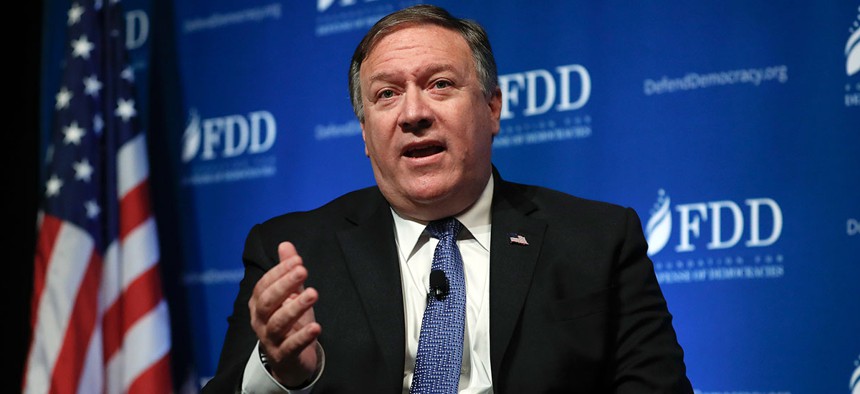
CIA Director Mike Pompeo speaks during the Foundation for Defense of Democracies National Security Summit in Washington on Oct. 19. Carolyn Kaster/AP
Washington Resumes Talking About Nuclear War
As the North Korean crisis escalates, the unthinkable has suddenly become discussable.
On an unseasonably warm October day recently, Donald Trump’s CIA director and national-security adviser appeared one after another at a conference in the nation’s capital. They soberly assessed the world’s greatest threats below the gentle light of chandeliers in a hotel ballroom. In between their remarks, D.C.’s cognoscenti spilled into an adjoining courtyard to conduct their own threat assessments over wraps and caesar salad. All was normal in Washington—except that two of the president’s top aides were signaling, with deadly seriousness, that conflict could soon erupt between two nuclear-weapons powers.
Talk of nuclear war—of the “general and universal physical fear” of being “blown up” at any moment, as William Faulkner once put it—subsided with the end of the Cold War. Americans instead cited “fear of the greenhouse effect, the ozone layer, and Chernobyl as dangers to the future,” a psychoanalyst told The New York Times in 1992, when George Bush and Boris Yeltsin officially concluded the rivalry between the nuclear superpowers. Just a few years ago, former U.S. Secretary of State John Kerry was observing that while it was good that “our children don’t know what the threat of nuclear war really feels like,” this generational divide made it more challenging to convey the urgency of ridding the world of its deadliest weapons.
But as North Korea’s nuclear program has rapidly advanced, and as the Trump administration has sounded the alarms about that progress, such talk is creeping back into public discourse in Washington and beyond. The president and his advisers have avoided explicit discussion of nuclear war. Yet they’ve spoken increasingly openly—and with remarkable stoicism—about the potentially catastrophic toll of a U.S.-North Korean conflict, not only because both countries possess nuclear weapons but because North Korea has formidable non-nuclear arms and shares a heavily militarized peninsula with South Korea.
At the October conference, which was organized by the Foundation for Defense of Democracies, CIA chief Mike Pompeo noted that North Korea may be just months away from developing the capacity to place a nuclear warhead on a long-range missile that can reach the United States. The North Koreans are so close, in fact, that U.S. policymakers should “behave as if we are on the cusp of them achieving that objective,” he said. As for what behavior he had in mind, Pompeo stressed that Trump would rather use peaceful tactics—economic sanctions, diplomatic pressure—to deny North Korea this capability. But the president is determined to keep Kim Jong Un from holding America hostage with nukes, he added, even if that requires taking military action against the North Korean leader.
Next, National-Security Adviser H.R. McMaster spoke to the relative probability of peace and war, and the timeline in which one could give way to the other. It is “unacceptable” to “accept and deter” a North Korean government that can threaten the United States with nuclear weapons, he said, even though America has for decades successfully deterred Russian and Chinesegovernments that can threaten the United States with nuclear weapons. He stated that the Trump administration would only enter into negotiations if North Korea agreed to take initial steps toward dismantling its nuclear-weapons arsenal, even though North Korean officials claim this precondition is a non-starter.
In banking on a long-shot diplomatic outcome and refusing to tolerate any lesser result, McMaster was hinting that military conflict is a distinct possibility—and not a distant one. He did more than drop hints. “We are in a race to resolve this short of military action,” McMaster acknowledged. As one U.S. official told NBC News, in reference to why U.S.-North Korean diplomatic channels are breaking down, the Trump administration’s message to North Korea appears to be “‘surrender without a fight or surrender with a fight.’”
Trump, for his part, has threatened to “totally destroy” North Korea with a show of force that “this world has never seen before” in order to protect America or its allies. U.S. military action against North Korea isn’t “unimaginable,” Joseph Dunford, the chairman of the Joint Chiefs of Staff, argued earlier this year, even though “anyone who has been alive since World War II has never seen the loss of life that could occur if there’s a conflict on the Korean peninsula.” What’s unimaginable, he continued “is allowing a capability that would allow a nuclear weapon to land in Denver, Colorado.”
Nuclear-weapons powers have very rarely engaged in direct military conflict; setting aside the many U.S.-Soviet proxy battles during the Cold War, the only precedent is brief, non-nuclear war clashes between China and Russia in 1969 and India and Pakistan in 1999. A nuclear war—in the sense of an exchange of nuclear weapons between countries—has never been fought. History is thus of limited help in understanding the stakes of the current standoff between the United States and North Korea. As a result, nobody’s quite sure what to make of the Trump administration’s rhetoric, let alone the Kim government’s blustery warnings of imminent nuclear armageddon.
U.S. Secretary of State Rex Tillerson, for instance, says his diplomatic campaign to counter North Korea “will continue until the first bomb drops,” while the Republican chairman of the Senate Foreign Relations Committee, Bob Corker, accuses Tillerson’s boss of leading the United States toward “world war.” On Twitter, speculation churns about U.S. military preparations in East Asia and whispers of war around D.C. Some analysts argue that even if the Trump administration conducts limited strikes against North Korea’s nuclear infrastructure, Kim Jong Un’s government, following a kind of “use it or lose it” logic, might deploy its nuclear weapons early in the conflict to compensate for its relative military weakness. Others assert that if the Trump administration is intent on eliminating North Korea’s nuclear capabilities and minimizing North Korean retaliation, the United States would likely be the first to use nuclear weapons—in a massive surprise attack. News outlets simultaneously reassure us that “We Shouldn’t Worry About Nuclear War With North Korea Right Now” and warn us that “A Nuclear War Between America and North Korea Is Very Possible.” Journalists are now asking their sources in Washington to estimate the odds of nuclear war with North Korea (10 percent, according to one retired Navy admiral, with a 20 to 30 percent chance of a non-nuclear military conflict); to weigh in on whether the president can be trusted with the nuclear codes (Corker has his doubts); to clear up whether Trump’s military advisers can “tackle him” or “lock him in a room” to prevent him from ordering a nuclear strike (the answer, from a legal perspective, is probably no).
Most of all, however, people are struggling to once again confront the specter of war with unimaginably destructive weapons. In a recent interview with Terry Gross of NPR, the New Yorker reporter Dexter Filkins recounted a conversation he’d had with “a very senior person” about how the U.S. military could use a nuclear weapon to wipe out North Korea’s leaders. “It’s terrifying,” Filkins admitted. “It’s just not even something that you want to think about.” Gross was mystified. “How do you use a nuclear weapon to decapitate the regime?” she asked. “God if I know. I don’t know. I mean, because—I don’t know,” Filkins responded. “I think that the idea, at least in the discussion that I had, was that that would be the only way that you could guarantee that you would basically obliterate the leadership, wherever it was. The problem with that, obviously, is that you’re going to end up obliterating a lot of other things as well.” Gross cut to a commercial break.







